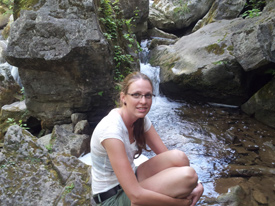
I am originally from Southern Ontario and completed my bachelor’s degree in 2010 at the University of Waterloo. I moved to Rouyn-Noranda in January 2013 to start my Master’s degree at UQAT, under the supervision of Brian Harvey. The objective of my Master’s project is to quantify the growth responses of residual white spruce trees in boreal mixedwood stands that have been subjected to various intensities of partial cutting treatments.
Formation académique
- Maîtrise en biologie, Université du Québec en Abitibi-Témiscamingue, Rouyn-Noranda, Qc, 2013 to Present
- Bachelor of Environmental Studies, University of Waterloo, 2005-2010
Projet de recherche : Évaluation de la réponse de croissance de l’épinette blanche (Picea glauca) à des intensités variables de coupes partielles dans des peuplements mixtes
Forest management practices have traditionally focused largely on sustainable timber yield and the economic gains associated with timber production. In many cases, harvesting practices such as clear-cutting and CPRS have converted complex, uneven aged (or complex structured) mixedwood stands into simpler, even aged stands. Moreover, because of differences between aspen and the shade-tolerant softwood species in terms of regeneration dynamics, sapling and tree growth, the softwood component in these stands is often in pre-commercial or small merchantable size classes when the aspen component arrives at a stage suitable for harvesting. Therefore there is clearly a silvicultural argument for applying partial cutting treatments in these types of stands. In the context of ecosystem management, the integration of natural stand dynamics into silvicultural practices is proposed as an important measure to maintaining vital ecosystem functions while meeting the timber requirements of the forestry industry. Partial cutting can be used to simulate natural succession dynamics by strategically removing trees from within a stand while maintaining some residual forest and subsequent ecosystem. Several studies have reported on the effects of partial cutting on tree regeneration but few have investigated the effects on growth and survival of residual trees. The purpose of my project is to quantitatively evaluate and compare radial and volume growth responses of residual white spruce trees in boreal mixedwood stands that have been subjected to various intensities of partial cutting. This study will also address the effects that social status (dominant, co-dominant, suppressed) and neighbouring tree environment have on growth responses in the various treatments.
Jessica Smith, Brian Harvey, Ahmed Koubaa, Suzanne Brais, Marc Mazerolle. Sprucing up the mixedwoods: Growth response of white spruce (Picea glauca) to partial cutting in the eastern Canadian boreal forest. 2016. Can. J. For. Res. 46(10):1205-1215
DOI : 10.1139/cjfr-2015-0489
Jessica Smith Réponses en croissance radiale et volume de l’épinette blanche (Picea glauca) aux coupes partielles dans des peuplements mixtes 16e colloque de la Chaire AFD. Université du Québec en Abitibi-Témiscamingue, Rouyn-Noranda, Québec. (2014-11-27)
Jessica Smith Réponses de croissance de l'épinette blanche (Picea glauca) à des intensités variables de coupes partielles dans des peuplements mixtes 15e colloque de la Chaire AFD. Université du Québec en Abitibi-Témiscamingue, Rouyn-Noranda, Québec. (2013-11-27)
